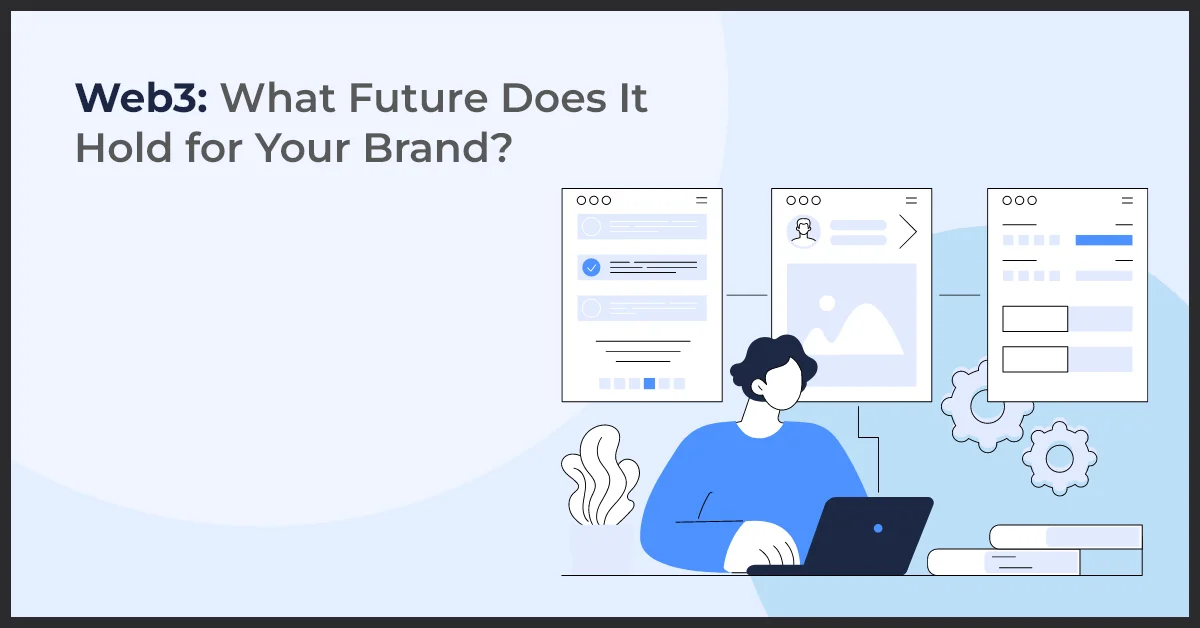Web3: What Future Does It Hold for Your Brand?

Published on: September 21, 2022
Updated on: July 12, 2024
1906 Views
- Digital Marketing
15 min read
Every few years, major shifts in the tech landscape stir up new buzzwords attached to them and are often regarded as an internet revolution. While most of these tech inventions are just temporary fads, some of these innovations stick around to change the way we use the internet.
Remember when bitcoin and cryptocurrency had everyone on the edge of their seats? That phase is definitely gone and now, Web3 is the new tech trend which most marketers can’t seem to get enough of.
When cryptocurrency became a subject of discussion, people learned much more about it and no longer looked at it as a quick means to making fortune overnight. Web3 is still new and people have no idea what it is, how to access its services, or formulate strategies to improve their brand. So, here we are.
Developing your brand’s strategy for Web3 is important as it will initiate the evolution of your digital approach to scaling your brand. Marc Andreessen of a16z called this movement “the second half of the internet”. Blockchain-based technologies are still in their infancy stages, but as history prepared us, Web3 is something unavoidable for marketers.
But first,
What Is Web3 Anyway?
As simple a question as it may look but the answer to this may change your approach to digital optimization of your business operations. The term Web3 was first coined by Gavin Wood, one of the creators of Ethereum. He defined Web3 as an alternative vision of the web, where the services are not hosted by a single service provider but everyone, and these are purely algorithmic.
Web 3 promises a user-led internet that is less susceptible to manipulation or control by centralized parties. Walled gardens—think enormous social networks, operating systems, browsers, and app stores—have dominated Web2; though a small number of corporations own these platforms, they have the power to make changes at will, damaging other businesses that have been built on top.
An early example of what Gavin and others favor in this area and want to see the growth of is BitTorrent and its peer-to-peer network for file sharing. Keep in mind that this scenario doesn't include a blockchain or call for a token or coin. If your use case does not require it, it should not have it, just like with other technological choices.
Understanding Web3: The Next Evolution of the Internet
Web3, or Web 3.0, represents the future of the Internet. It goes beyond the traditional website-centered model of Web2 and envisions a decentralized and user-centric online ecosystem. At its core, Web3 aims to empower individuals, redefine digital ownership, and revolutionize how we interact with information and services online.
So, how did we get here? Web2, the current state of the Internet, brought us incredible innovations like social media, e-commerce, and cloud computing. However, it also introduced data privacy concerns, centralized control, and an alarming concentration of power in the hands of a few tech giants.
Web3 takes a different approach. It is built on distributed ledger technologies such as blockchain, allowing for greater transparency, security, and trust. It embraces the idea of decentralization, where users are not just consumers but active participants in a network of interconnected applications and protocols.
One of the key characteristics of Web3 is the concept of sovereignty. Individuals regain control over their digital identity, assets, and privacy. This means that users have true ownership of their data, can seamlessly transfer assets without intermediaries, and have the freedom to choose which applications and platforms to engage with.
In addition to sovereignty, Web3 emphasizes interoperability, or the ability for different platforms and applications to communicate and share data effectively. This allows for the creation of interconnected ecosystems where information can flow seamlessly, fostering innovation and collaboration.
Web3 is based on a set of principles that promote openness, inclusivity, and collaboration. It encourages transparency through auditable smart contracts, encourages developers to build open-source applications, and seeks to create fair and equitable systems that benefit everyone involved.
As we venture into the exciting world of Web3, it is essential to understand its evolving nature, its potential to revolutionize industries, and the opportunities it presents for individuals to regain control over their digital lives. Join us on this journey as we explore the endless possibilities of Web3 and what it means for the future of the Internet.
A. Internet and Blockchain
Web3 is the next generation of the internet that leverages blockchain technology to revolutionize online interactions and transactions. It builds upon the foundation of the traditional internet, enhancing it with decentralized and trustless systems.
In Web3, the relationship between the internet and blockchain is essential. Blockchain technology acts as the underlying infrastructure that powers Web3, enabling secure and transparent transactions without the need for intermediaries.
B. Decentralization and Distributed Power
In the context of Web3, decentralization refers to the distribution of power and control among participants. Unlike the centralized entities in Web2, Web3 aims to create a network where the power is distributed among its users, ensuring a more democratic and inclusive system.
Contrasting centralized entities, Web3 embraces distributed control, where decisions and actions are made collectively by the network participants. This shift empowers individuals, avoids single points of failure, and reduces the vulnerability to censorship and manipulation.
The benefits of decentralized structures in Web3 are profound. It removes the reliance on trusted intermediaries, fosters greater transparency, and reduces costs associated with middlemen. Moreover, decentralization paves the way for innovation, as developers can build decentralized applications (DApps) that leverage the power of the network.
C. Key Components of Web3
1. Ethereum
Ethereum is a blockchain platform that plays a pivotal role in the Web3 ecosystem. It allows developers to create and deploy smart contracts, which are self-executing agreements coded onto the blockchain. Smart contracts enable the development of decentralized applications (DApps), offering programmable and trustless interactions.
Through Ethereum, Web3 unlocks the potential for secure and decentralized applications that operate without intermediaries, ensuring autonomy, transparency, and immutability.
2. Smart Contracts
In Web3, smart contracts are computer programs that automatically execute predefined actions when specific conditions are met. They serve as the building blocks for decentralized systems, enabling trust and efficiency between parties without relying on intermediaries or manual intervention.
By automating interactions within decentralized systems, smart contracts uphold the principles of Web3, ensuring transparency, security, and trust among participants.
3. Interoperability
Interoperability is crucial for Web3 to achieve its full potential. It refers to the ability of different blockchain networks and decentralized applications (DApps) to communicate and exchange data seamlessly. Interoperability allows for a unified ecosystem, where decentralized systems can leverage the functionalities of other networks, creating more robust and versatile applications.
With interoperability, decentralized applications can share and exchange data, interact with various blockchain networks, and facilitate complex transactions across different protocols.
4. Internet of Things (IoT)
Web3 envisions a future where the Internet of Things (IoT) interacts securely and autonomously. By combining blockchain technology and decentralized networks, Web3 enables peer-to-peer communication among IoT devices, eliminating the need for centralized control.
The integration of IoT and Web3 empowers devices to securely exchange data, ensure privacy, and automate processes without relying on a central authority. This opens up possibilities for smart cities, autonomous vehicles, and efficient supply chain management, among others.
Values and Principles of Web3
A. Privacy and Security
Web3 places a strong emphasis on user control and the protection of personal data. Unlike Web2, where user data is often stored and controlled by centralized entities, Web3 aims to give individuals greater control over their own information. This shift towards decentralization reduces the risk of large-scale data breaches and unauthorized access to personal data.
- Emphasis on user control: Web3 platforms prioritize empowering users to have full control over their personal data. This means individuals can decide how their information is shared, stored, and used.
- Safeguarding against data breaches: Through the use of cryptographic technology and decentralized systems, Web3 enhances security measures to protect against potential data breaches.
B. Tokenization
Tokenization plays a pivotal role in the Web3 ecosystem. It involves the representation of various assets, services, and even entire economies through digital tokens. These tokens, based on blockchain technology, enable new possibilities for ownership, value exchange, and participation.
- Introduction to tokenization: Web3 introduces the concept of tokenization, which revolutionizes the representation of assets and services in the digital realm. Tokens can represent physical assets (like real estate or artwork), digital assets (such as in-game items or intellectual property), and even intangible assets (like reputation or voting power).
- Digital representation of assets: Through tokenization, Web3 allows assets to be easily tokenized, enabling efficient transfer, tracking, and ownership verification. This creates new opportunities for peer-to-peer transactions with reduced friction.
C. Governance
Web3 fosters the exploration of new governance models, including Decentralized Autonomous Organizations (DAOs), which distribute decision-making power more evenly among participants through voting mechanisms.
- Exploration of new governance models: Web3 encourages the development of innovative governance models that challenge traditional centralized authority structures. DAOs, for example, enable community-driven decision-making by allowing token holders to vote on proposals and influence the direction of projects and platforms.
- Distribution of decision-making power: With Web3, decision-making power is distributed across participants, allowing for more inclusive and democratic decision-making processes. This decentralized governance model aims to prevent concentration of power and promote collective decision-making.
Web3 Ecosystem
A. Web3 Tools and Protocols
Web3 ecosystem is supported by various tools and protocols that enable decentralized applications and services:
- Decentralized Storage Solutions: These solutions provide secure and censorship-resistant storage options for Web3 applications. Examples include IPFS and Filecoin.
- Identity Systems: Web3 is centered around self-sovereign identity, allowing users to control their own digital identities. Tools like Sovrin and uPort facilitate this.
- Developer Frameworks: Frameworks like Truffle and Embark help developers build and deploy Web3 applications effectively by providing a set of pre-built tools and libraries.
B. Impact on Industries and Companies
Web3 technology is transforming various industries and disrupting traditional business models:
- Finance: Web3 enables decentralized finance (DeFi), providing open and permissionless alternatives to traditional financial services. Companies like Uniswap and MakerDAO are leading this transformation.
- Social Media: Web3 introduces new models where users have control over their own data and are incentivized for their contributions. Platforms like Steemit and Mastodon are building decentralized social networks.
- Gaming: Web3 allows for true ownership of in-game assets, provable scarcity, and interoperability between different games. Projects like Axie Infinity and Decentraland are revolutionizing the gaming industry.
C. Crypto and the Role of Cryptocurrencies
Cryptocurrencies play a vital role in the Web3 ecosystem:
- Relevance: Cryptocurrencies provide the means to incentivize and reward participants within decentralized networks. They also serve as a medium of exchange for transactions within Web3 applications.
- Utilization: Within decentralized applications, cryptocurrencies are used for various purposes, such as governance, staking, and micropayments. Examples include Ethereum's Ether and Polkadot's DOT token.
Comparison with Web2
Web3 represents a significant shift from its predecessor, Web2. While Web2 has been dominant for the past two decades, Web3 offers a revolutionary approach to the online experience. Let's explore the key distinctions between Web3 and Web2:
1. Distinctions between Web3 and Web2
Web2 is characterized by centralized platforms and services where users rely on intermediaries to store and control their data. On the other hand, Web3 strives for decentralization by using blockchain technology and peer-to-peer networks. This eliminates the need for intermediaries and gives users direct control over their data.
2. Key differences in terms of data, control, and user interaction
- Data: Web2 platforms often collect and store user data, which can be vulnerable to breaches and misuse. With Web3, data is stored on decentralized networks, encrypted, and allows users to have ownership and control over their personal information.
- Control: In Web2, users have limited control over their online actions and interactions. Web3 provides users with full control over their digital identity, allowing them to decide how and with whom their data is shared.
- User Interaction: Web3 introduces new concepts like decentralized applications (DApps) and smart contracts, enhancing user interactions. Unlike Web2, where user interaction is limited to centralized platforms, Web3 enables users to engage directly with the underlying blockchain technology.
Overall, Web3 represents a paradigm shift in how we interact with the internet. It empowers individuals by giving them control over their online presence and data. The transition from Web2 to Web3 brings about a more secure, transparent, and user-centric online ecosystem.
Now that we have explored the world of Web3, let's recap the key aspects and principles that define this revolutionary concept.
Recap of key aspects and principles of Web3
- Web3 is the next evolution of the internet, aiming to create a more decentralized and user-centric digital infrastructure.
- It is built on blockchain technology, enabling trust, transparency, and peer-to-peer interactions.
- Web3 emphasizes principles such as data ownership, privacy, and user control over personal information.
- Smart contracts, decentralized finance, and decentralized applications (dApps) are integral components of the Web3 ecosystem.
As we conclude our discussion on Web3, it's important to consider the potential impact this paradigm shift may have on society and technology.
Discussion of the potential impact of Web3 on society and technology
Web3 has the potential to revolutionize various aspects of our lives. With its decentralized nature, Web3 can empower individuals by giving them greater control over their data and online identities. This could foster a more inclusive digital economy that is not dominated by a few centralized entities.
Moreover, Web3 can reshape industries such as finance, healthcare, and supply chain management. By eliminating intermediaries and enabling more efficient and transparent processes, it can lead to cost savings, improved security, and enhanced trust.
However, it's important to acknowledge the challenges that may arise with the adoption of Web3. Balancing privacy with security, addressing regulatory concerns, and ensuring accessibility for all users will be crucial for the successful implementation of Web3.
In conclusion, Web3 represents a paradigm shift that has the potential to transform the internet as we know it. Its decentralized and user-centric approach promises greater privacy, control, and transparency. While there are challenges to be overcome, the possibilities offered by Web3 are undeniably exciting and hold the potential to reshape our society and technology.
How Will Web3 Transform Online Marketing?
Web3 is enabling online marketers to advance, who are depending on data privacy in this decentralized internet epoch. As a result of Web3's data gathering and use limits, marketers will change the way we think about online marketing. Since Web3 puts users in control, it will be harder for marketers to focus on creating communities.
With Web3, users will be able to share their interests and ideas. Brands will need to establish communities that promote these discussions in order to communicate their messages more effectively.
But the million dollar question is,
Is your brand elastic enough to expand under the new cultural and social norms?
If not, we bring you three ways how Web3 can help elevate your brand.
1. Enter a New World of Possibilities
Have you ever heard about brand elasticity? Well, it is a measure of a brand's potential to become established in a new industry. In order to do it, brands must be able to utilize their worth and reputation to create market trust.
Marketers who subtly develop their strategies may find themselves enthralled by the aggressivity that results from a well-known brand declaring its Web3 intent. There are numerous ways to provide current customers new experiences and attract new customers for current items.
2. Move Toward Decentralization
Decentralized apps are the best as they improve accessibility and change how we use social media. Although Facebook and Instagram are fantastic social media platforms, they also have total control over their offerings.
The data of people using these apps is not under the jurisdiction of any one entity. This gives users a lot of control. Through dApps, brands have a special chance to develop relationships with consumers.
3. Balance Real and Virtual Worlds
Experiential marketing is a major area of attention on Web3. To keep up with the changing market environment, brands must modify their marketing strategy. Brands should therefore use a hybrid strategy that combines their work in the virtual and physical worlds.
Brands must make sure that their voice can effectively communicate with customers in both nations while navigating boundaries. You may achieve this by developing engaging, interactive aspects and experiences.
Web3: Future Outlook
The "second half of the Internet," such as the smart contracts that keep us connected to our consumers, is still in the early stages of development. As we are just joining this space, the quick speed of innovation in Web3 can be intimidating.
Do not be concerned with marketers seeking to enter the conflict. More brands will finally enter the market in the upcoming months through partnerships and experimentation.
Is your brand looking to enter the world of Web3? Growth Natives have got your back. Our experts will analyze and suggest to you what your brand needs to be fully prepared for the future of the internet with Web3. Get in touch with us at info@growthnatives.com
Frequently Asked Questions
The future of Web3 is envisioned as a decentralized web where users have more control over their data and interactions online. It includes technologies such as blockchain, cryptocurrencies, and decentralized applications (dApps) that aim to create a more transparent, secure, and user-centric internet.
Web3 matters for brands because it presents new opportunities to interact with customers, engage in decentralized ecosystems, and explore innovative business models. Brands that embrace Web3 can gain a competitive advantage and stay relevant in a rapidly evolving digital landscape.
Brands are using Web3 for various purposes, including:
- NFTs (Non-Fungible Tokens): Creating and selling digital collectibles and assets.
- Decentralized Finance (DeFi): Exploring new financial services and models.
- Decentralized Autonomous Organizations (DAOs): Engaging communities and stakeholders in decision-making processes.
- Supply chain transparency: Using blockchain to track and verify the authenticity of products.
Web3 can help marketing by:
- Enhancing customer trust and loyalty through transparent and secure interactions.
- Enabling new forms of content monetization, such as NFTs.
- Facilitating more personalized and targeted marketing efforts through decentralized data sharing.
- Allowing brands to engage with communities and customers in innovative ways through DAOs and decentralized platforms.



